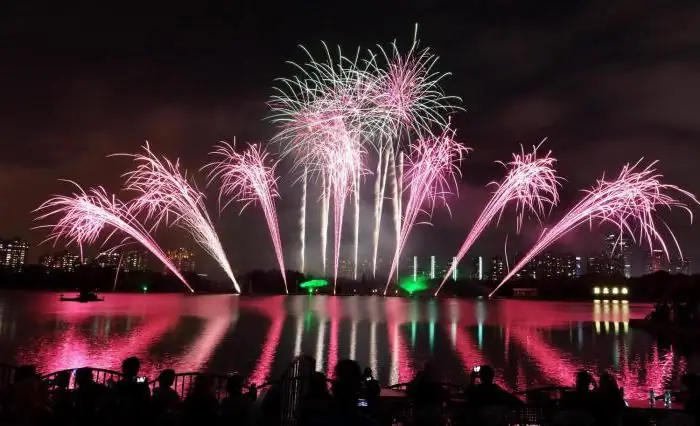- Author Harold Hamphrey [email protected].
- Public 2023-12-17 10:06.
- Last modified 2025-01-24 11:10.
Water trips are the kind of outdoor activities that are becoming more and more popular with us. It is not surprising: in our country there are many turbulent mountain rivers, the amazing beauty of lakes and seas. Sailing, rowing, canoeing, kayaking, catamarans, rafting, kayaking and rafting - the world of water tourism is very diverse. Recently, a new type of extreme recreation has appeared: overcoming obstacles (cascades and waterfalls) without watercraft at all, in some heat-saving suits. This article is devoted to the organization of water trips. How to anticipate all hazards and avoid them? How to achieve that delicate balance so that all participants in the campaign experience strong emotions from the riot of wildlife, and at the same time know that they are protected as much as possible?

Development of the route and schedulemovement
Preparation for a water trip requires not only knowledge of the area, but also taking into account climatic and weather conditions, the composition of tourists, their experience and endurance, and the choice of watercraft. Not all rivers are suitable for travel: shallows, thickets, low bridges, and dams are often found on shallow ones. In large water areas, large vessels pose a danger. Mountain rivers suitable for rafting are classified according to their complexity into points: from one (the easiest) to six (the most extreme). This should be taken into account when choosing a team for a trip. Climatic and especially weather conditions can make adjustments to the level of difficulty of the planned route. If there are beginners in the group, you should not choose rivers whose slope exceeds 1.5 m per kilometer. When you plan to go against the current, then in sections with an elevation angle of 1-1, 2 m, you need to make wiring in advance, pull the rope or put up poles. It is also necessary to provide places for h alts and overnight stays.

Organization of a water trip
The person in charge of the voyage must conduct a thorough inspection of the watercraft. Unlike hiking trips, on the water, all participants must feel like a single team, ready to face the danger to life. And because the discipline must be tough, as in the army. A preliminary briefing should be carried out, during which the participants should be familiarized with the management of the watercraft, discuss their actions in case of emergencies, and distribute responsibilities among the team members.

The safety of water trips largely depends on the coordinated actions of the entire group. If there are beginners in the team, put them in a kayak or kayak with an experienced tourist. No matter how excellent your boats are, take the group's repairman with you on your hike. Things like spare paddles, thin rubber for patches, glue and a pump are a must.
During the hike
The organizer and captains of individual kayaks, catamarans or rafts must be able to read navigation signs installed along the coast and in the water area itself, know the elementary rules of behavior on the water. On large rivers, it is necessary to stay close to the shore, since the movement of barges and steamers, motorized vessels creates a wave that is dangerous for light punts. When stopping for the night, it is necessary to pull out all watercraft ashore and turn them upside down. The equipment of a tourist going on water trips should be more diverse. Among other things, he should stock up on rowing gloves, a waterproof hermetic bag, where to put a full set of clothes and shoes. Products that can be damaged by contact with water are wrapped in plastic wrap. Heavier loads are placed in the aft compartment, and lighter loads are placed in the bow. Personal belongings of tourists are tied to balloons. On catamarans, it is important to distribute luggage so that the load on the starboard and port sides is the same.

Move along the route
Water trips must take place in such a way that the organizer cansee and give orders to the captains of individual kayaks or catamarans. The pace of work with oars is set by the front rower. At the same time, the captain or his assistant steers the ship. On calm water, kayaks or kayaks can move in a “flock”, but in fast current they need to line up in one line. In a shallow place where sharp stones and a chaotic wave can be dangerous for a kayak, the leader (on the first boat) gives the command: "Line up in the wake column." All ships line up with a distance of one or two hulls, and follow the leader of the campaign. If the catamaran runs aground, it is unloaded, led on a rope (or carried by hand) and refilled with luggage. In extreme areas, the team leaves the ship, bypassing it along the shore. The boat is transported by drag or on a string. The assistant organizer closes the column of boats. He should also have a repair tool bag.
Personal protective equipment
Water trips have their own specifics. In addition to a spare set of clothing, each participant must have a life jacket or a cork/foam belt. If the journey takes place along a stormy mountain river, then a motorcycle-type helmet is required to protect the head from hitting stones. Hike upstream is associated with active rowing, and therefore mittens with cut fingers are needed. It must also be remembered that, unlike hiking, in water the load is not on the legs, but on the muscle groups of the shoulders, chest, arms and back. In the first aid kit, you must have an anesthetic and warming cream.

Emergencies in the water trip
Traveling on water, and especially rafting on mountain rivers, is to some extent an extreme form of recreation. Therefore, all participants in the campaign must be psychologically prepared for the fact that their boat will capsize, and they themselves will find themselves in cold and stormy water. Confusion and succumbing to danger are as harmful as overestimating one's capabilities. Even before the start of the trip, it is necessary to “lose” with all the participants all possible emergencies in the water trip. It is necessary to bring to automaticity the algorithm of actions of the whole team and the victim himself in this or that danger. It is even advisable to practice in the water, developing the skill of throwing and receiving a rescue line, riding a kayak, swimming in a life jacket in a rough current, etc.






